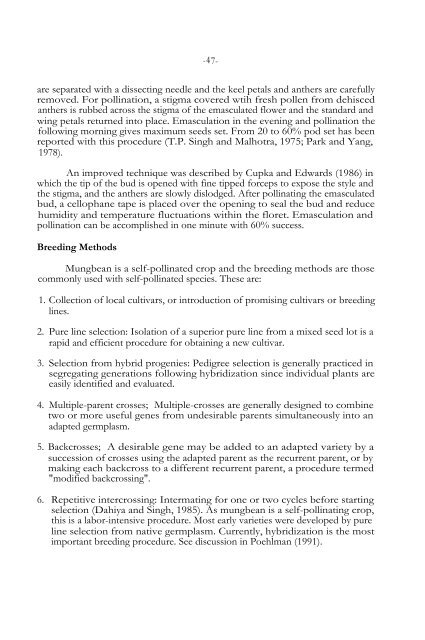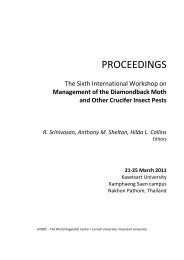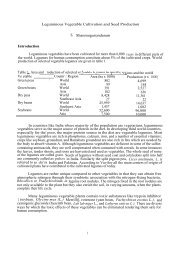MUNGBEAN VARIETAL IMPROVEMENT S. Shanmugasundaram
MUNGBEAN VARIETAL IMPROVEMENT S. Shanmugasundaram
MUNGBEAN VARIETAL IMPROVEMENT S. Shanmugasundaram
Create successful ePaper yourself
Turn your PDF publications into a flip-book with our unique Google optimized e-Paper software.
-47-<br />
are separated with a dissecting needle and the keel petals and anthers are carefully<br />
removed. For pollination, a stigma covered wtih fresh pollen from dehisced<br />
anthers is rubbed across the stigma of the emasculated flower and the standard and<br />
wing petals returned into place. Emasculation in the evening and pollination the<br />
following morning gives maximum seeds set. From 20 to 60% pod set has been<br />
reported with this procedure (T.P. Singh and Malhotra, 1975; Park and Yang,<br />
1978).<br />
An improved technique was described by Cupka and Edwards (1986) in<br />
which the tip of the bud is opened with fine tipped forceps to expose the style and<br />
the stigma, and the anthers are slowly dislodged. After pollinating the emasculated<br />
bud, a cellophane tape is placed over the opening to seal the bud and reduce<br />
humidity and temperature fluctuations within the floret. Emasculation and<br />
pollination can be accomplished in one minute with 60% success.<br />
Breeding Methods<br />
Mungbean is a self-pollinated crop and the breeding methods are those<br />
commonly used with self-pollinated species. These are:<br />
1. Collection of local cultivars, or introduction of promising cultivars or breeding<br />
lines.<br />
2. Pure line selection: Isolation of a superior pure line from a mixed seed lot is a<br />
rapid and efficient procedure for obtaining a new cultivar.<br />
3. Selection from hybrid progenies: Pedigree selection is generally practiced in<br />
segregating generations following hybridization since individual plants are<br />
easily identified and evaluated.<br />
4. Multiple-parent crosses; Multiple-crosses are generally designed to combine<br />
two or more useful genes from undesirable parents simultaneously into an<br />
adapted germplasm.<br />
5. Backcrosses; A desirable gene may be added to an adapted variety by a<br />
succession of crosses using the adapted parent as the recurrent parent, or by<br />
making each backcross to a different recurrent parent, a procedure termed<br />
"modified backcrossing".<br />
6. Repetitive intercrossing: Intermating for one or two cycles before starting<br />
selection (Dahiya and Singh, 1985). As mungbean is a self-pollinating crop,<br />
this is a labor-intensive procedure. Most early varieties were developed by pure<br />
line selection from native germplasm. Currently, hybridization is the most<br />
important breeding procedure. See discussion in Poehlman (1991).

















